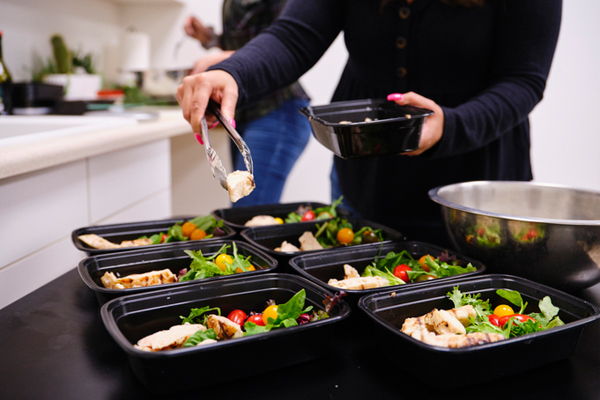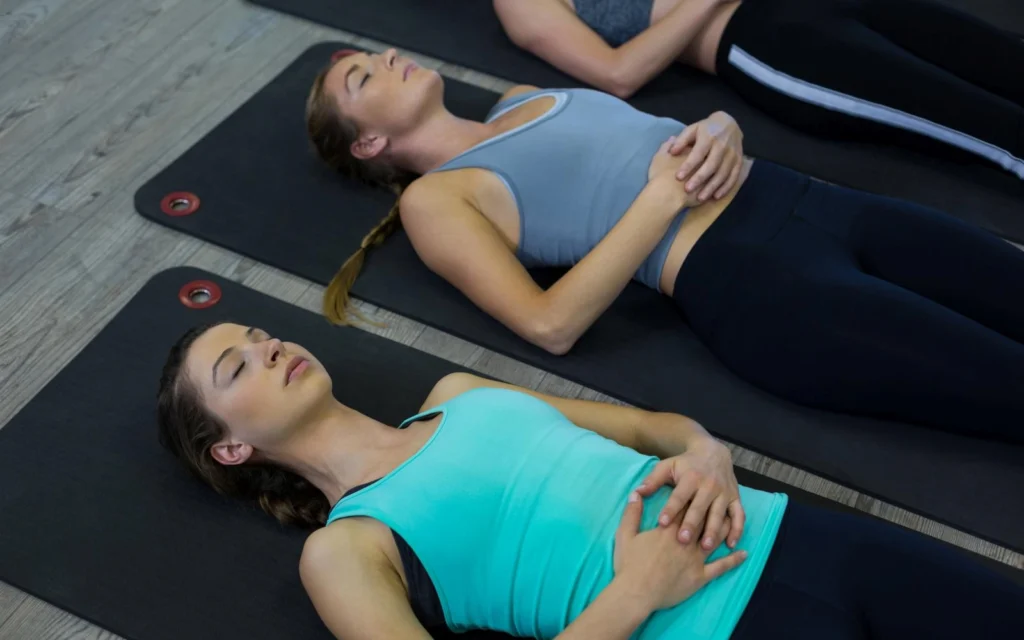More Than Just Gym Gains
“What’s the point of lifting heavy if you can’t carry groceries without straining your back?”
That’s the core idea behind functional fitness — training not just for muscle size or looks, but for real-life strength that supports everyday movement. Unlike workouts that focus purely on aesthetics, functional fitness prepares your body for practical, day-to-day actions.
Think of how often you bend, twist, lift, or carry things — climbing stairs, getting up from a chair, picking up your child, or even reaching for something high up. Functional training helps you do these things better, without pain or effort.
It’s based on exercises that mimic natural movement patterns — like squats, lunges, pushes, pulls, and carries — using multiple muscles at once. These patterns improve your posture, balance, stability, and overall coordination.
Whether you’re a beginner or someone looking for a more useful fitness approach, this article will walk you through what functional fitness is, the key movements involved, and why it’s worth including in your weekly routine. You don’t just want a strong body — you want a body that works for you.
What is Functional Fitness, Really?
Functional fitness is a style of training that focuses on movements, not just muscles. Instead of isolating one muscle at a time, like biceps curls or leg extensions, functional exercises train your body to move as a unit, just like it does in everyday life.
For example, picking up a box from the floor uses your legs, hips, core, and arms all at once. A functional movement like a deadlift or a squat mimics this action. The goal is to build strength, stability, and mobility that directly translate to real-world activities.
This type of training emphasizes:
-
Multi-joint movements
-
Core engagement
-
Balance and coordination
-
Movement across different planes (forward, backward, twisting)
Contrast this with traditional gym workouts where you may sit on a machine and isolate one part of the body. While that can help with muscle growth, it often misses the bigger picture — how your body moves together.
Think about everyday tasks:
-
Sitting and standing
-
Carrying heavy bags
-
Rotating to reach something
-
Lifting your child
-
Climbing stairs
Functional fitness prepares you for all of that. It makes your training more purposeful and less about just looking good — though looking better is often a bonus side effect.
Core Movements That Mimic Real Life
Functional fitness is built around six core movement patterns. These mimic how we move in everyday situations and train multiple muscle groups at once.
1. Squats
-
Example in life: Sitting down and standing up, picking something off the ground.
-
Muscles worked: Quads, glutes, core.
-
Exercise examples: Bodyweight squats, goblet squats.
2. Hinges (Deadlift-type movements)
-
Example in life: Bending to lift a bag or child.
-
Muscles worked: Hamstrings, glutes, lower back.
-
Exercise examples: Romanian deadlifts, kettlebell swings.
3. Lunges
-
Example in life: Climbing stairs, kneeling, walking with purpose.
-
Muscles worked: Quads, glutes, calves, core.
-
Exercise examples: Forward lunges, walking lunges.
4. Push
-
Example in life: Pushing a door, moving furniture.
-
Muscles worked: Chest, shoulders, triceps.
-
Exercise examples: Push-ups, overhead presses.
5. Pull
-
Example in life: Opening a drawer, pulling a heavy object.
-
Muscles worked: Back, biceps.
-
Exercise examples: Dumbbell rows, resistance band pulls.
6. Carries
-
Example in life: Carrying grocery bags, luggage.
-
Muscles worked: Core, grip, shoulders.
-
Exercise examples: Farmer’s walk, suitcase carry.
7. Rotation (Bonus pattern)
-
Example in life: Turning, reaching, twisting in sports or chores.
-
Muscles worked: Obliques, spine stabilizers.
-
Exercise examples: Russian twists, cable woodchoppers.
Training these patterns consistently makes you more capable, efficient, and injury-resistant in the real world.
Benefits of Functional Training Beyond the Gym
Functional fitness goes far beyond just “working out.” It brings real improvements to how you feel and function every day.
✅ Improved Posture & Joint Health
Functional exercises target stabilizer muscles and core strength, improving how you sit, stand, and move. Over time, this reduces slouching and discomfort.
✅ Reduced Risk of Injury
By training your body to move better — with proper alignment and coordination — you’re less likely to strain your back or pull a muscle doing normal tasks.
✅ Better Balance & Coordination
Many functional exercises involve movement while balancing your bodyweight. This sharpens your reflexes and steadiness — especially useful as you age.
✅ Boosted Everyday Performance
Lifting groceries, walking up stairs, getting in and out of cars — all these feel easier when your muscles work in sync.
✅ Supports Sports & Active Hobbies
Functional training improves overall body mechanics. Whether you’re playing badminton, dancing, or going on a trek — you’ll move better and with more confidence.
✅ Mental Satisfaction
Because functional training feels connected to real movement, it often feels more rewarding and engaging than isolated machine workouts.
You don’t need to be an athlete to benefit — anyone who moves can benefit from functional fitness.
Sample Functional Workout Plan
Here’s a simple beginner-friendly functional fitness circuit that you can perform at home or in the gym with minimal equipment. This circuit targets key movement patterns and helps build strength, stability, and mobility.
Start with a light warm-up of 3–5 minutes: arm circles, leg swings, bodyweight squats, and dynamic stretches.
Functional Circuit (Perform 2–3 rounds):
-
Bodyweight or Goblet Squats – 12 reps
-
Dumbbell Deadlifts – 10 reps
-
Walking Lunges – 8 reps each leg
-
Incline Push-Ups or Standard Push-Ups – 10–12 reps
-
Farmer’s Carries – 30 seconds walk holding weights
-
Plank or Side Planks – 30 seconds hold
Rest for 30–60 seconds between exercises, and take 1–2 minutes between rounds. Focus on controlled movements and good form rather than speed.
This circuit can be done three times a week on non-consecutive days. As you progress, increase the weight, add another round, or increase hold/walk durations to challenge your endurance and strength further. You can also swap exercises for variations such as sumo squats, reverse lunges, or elevated push-ups to introduce diversity while sticking to the same movement patterns.
The goal isn’t to exhaust yourself, but to build a foundation of movements that carry over into real-life activities. With consistency, you’ll start noticing how much easier daily tasks become.
Adapting Functional Training to Your Lifestyle
Functional fitness is flexible. You don’t need a gym or a full hour to include these movements in your day — they can be seamlessly integrated into your existing lifestyle.
At home, bodyweight squats, lunges, push-ups, and planks require no equipment and take just 15–20 minutes. You can do a short routine in the morning or as an active break during the day. Keeping a pair of dumbbells or resistance bands nearby adds more variety.
In the office, you can include mini-movements like chair squats, desk push-ups, or standing core rotations. Walking during calls and stretching every hour keeps your body active and prevents stiffness from long periods of sitting.
Functional training is also perfect for mobility work. Adding 5–10 minutes of lunges, hip hinges, and rotation drills before your main workouts or sports sessions can enhance movement quality and reduce injury risk.
Regardless of age, injury history, or fitness level, functional fitness can be tailored. For older adults or those recovering from injury, reduce range of motion, lower resistance, and slow the tempo. Beginners can start with bodyweight-only versions. The movements stay the same — only the intensity and scale change to suit your needs.
Train for Life, Not Just for Looks
Functional fitness is about building a body that works — not just one that looks good in the mirror. When you train with real-life movement in mind, you’re preparing yourself for the physical demands of daily living. From lifting, bending, and twisting to balancing and carrying — functional exercises equip you for it all.
It’s not about chasing perfection in form or physique. It’s about moving well, feeling strong, and staying capable as you age. Whether you’re just starting your fitness journey or rethinking how you train, functional fitness is a sustainable, intelligent approach that rewards consistency.
Fitness isn’t just what you do in the gym — it’s how well you move in the rest of your life. When your training supports the way you live, every rep counts for more.



